Note
Go to the end to download the full example code.
RP55 analysis and 2D graphics¶
The objective of this example is to present problem 55 of the BBRC. We also present graphic elements for the visualization of the limit state surface in 2 dimensions.
The dimension is equal to 2 and the probability is close to $10^{-2}$. This makes this problem relatively easy to solve. The distribution is uniform in the square $[-1,1]^2$. The failure domain is made of 5 diagonal bands. Capturing these bands is relatively easy and a Monte-Carlo simulation perform well in this case. The FORM method cannot perform correctly, since the failure domain cannot be linearized in the gaussian space. Hence, the SORM or FORM-IS methods do not perform satisfactorily.
import openturns as ot
import otbenchmark as otb
import openturns.viewer as otv
Disable warnings
ot.Log.Show(ot.Log.NONE)
problem = otb.ReliabilityProblem55()
print(problem)
name = RP55
event = class=ThresholdEventImplementation antecedent=class=CompositeRandomVector function=class=Function name=Unnamed implementation=class=FunctionImplementation name=Unnamed description=[x1,x2,gsys] evaluationImplementation=class=SymbolicEvaluation name=Unnamed inputVariablesNames=[x1,x2] outputVariablesNames=[gsys] formulas=[var g1 := 0.2 + 0.6 * (x1 - x2)^4 - (x1 - x2) / sqrt(2);var g2 := 0.2 + 0.6 * (x1 - x2)^4 + (x1 - x2) / sqrt(2);var g3 := (x1 - x2) + 5 / sqrt(2) - 2.2;var g4 := (x2 - x1) + 5 / sqrt(2) - 2.2;gsys := min(g1, g2, g3, g4)] gradientImplementation=class=SymbolicGradient name=Unnamed evaluation=class=SymbolicEvaluation name=Unnamed inputVariablesNames=[x1,x2] outputVariablesNames=[gsys] formulas=[var g1 := 0.2 + 0.6 * (x1 - x2)^4 - (x1 - x2) / sqrt(2);var g2 := 0.2 + 0.6 * (x1 - x2)^4 + (x1 - x2) / sqrt(2);var g3 := (x1 - x2) + 5 / sqrt(2) - 2.2;var g4 := (x2 - x1) + 5 / sqrt(2) - 2.2;gsys := min(g1, g2, g3, g4)] hessianImplementation=class=SymbolicHessian name=Unnamed evaluation=class=SymbolicEvaluation name=Unnamed inputVariablesNames=[x1,x2] outputVariablesNames=[gsys] formulas=[var g1 := 0.2 + 0.6 * (x1 - x2)^4 - (x1 - x2) / sqrt(2);var g2 := 0.2 + 0.6 * (x1 - x2)^4 + (x1 - x2) / sqrt(2);var g3 := (x1 - x2) + 5 / sqrt(2) - 2.2;var g4 := (x2 - x1) + 5 / sqrt(2) - 2.2;gsys := min(g1, g2, g3, g4)] antecedent=class=UsualRandomVector distribution=class=JointDistribution name=JointDistribution dimension=2 copula=class=IndependentCopula name=IndependentCopula dimension=2 marginal[0]=class=Uniform name=Uniform dimension=1 a=-1 b=1 marginal[1]=class=Uniform name=Uniform dimension=1 a=-1 b=1 operator=class=Less name=Unnamed threshold=0
probability = 0.5600144282863704
event = problem.getEvent()
g = event.getFunction()
problem.getProbability()
0.5600144282863704
Compute the bounds of the domain¶
inputVector = event.getAntecedent()
distribution = inputVector.getDistribution()
X1 = distribution.getMarginal(0)
X2 = distribution.getMarginal(1)
alphaMin = 0.00001
alphaMax = 1 - alphaMin
lowerBound = ot.Point(
[X1.computeQuantile(alphaMin)[0], X2.computeQuantile(alphaMin)[0]]
)
upperBound = ot.Point(
[X1.computeQuantile(alphaMax)[0], X2.computeQuantile(alphaMax)[0]]
)
nbPoints = [100, 100]
figure = g.draw(lowerBound, upperBound, nbPoints)
figure.setTitle("Iso-values of limit state function")
_ = otv.View(figure)
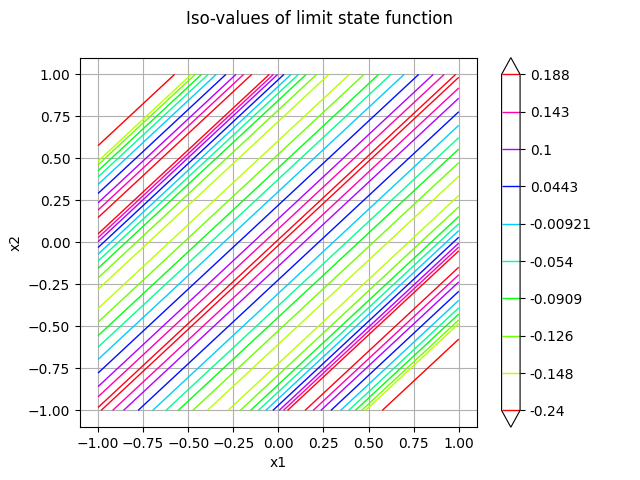
Plot the iso-values of the distribution¶
_ = otv.View(distribution.drawPDF())
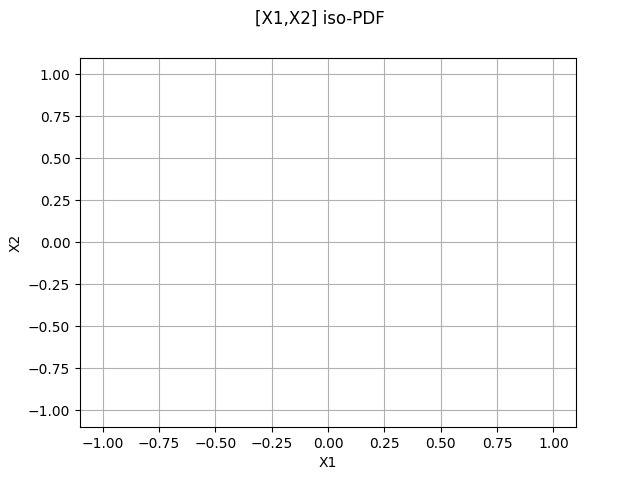
sampleSize = 5000
sampleInput = inputVector.getSample(sampleSize)
sampleOutput = g(sampleInput)
drawEvent = otb.DrawEvent(event)
cloud = drawEvent.drawSampleCrossCut(sampleSize)
_ = otv.View(cloud)
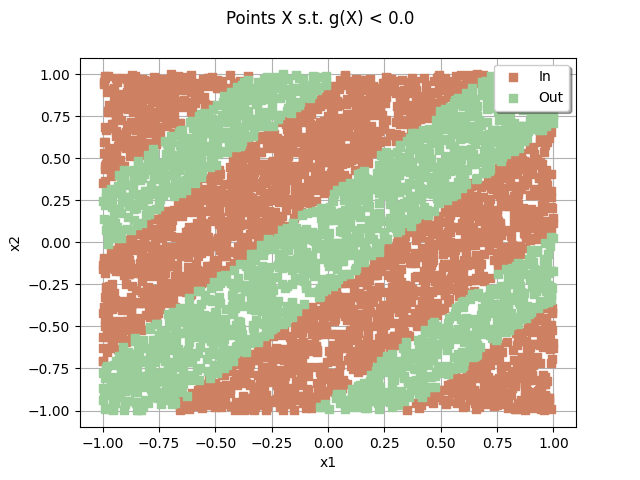
Draw the limit state surface¶
bounds = ot.Interval(lowerBound, upperBound)
bounds
graph = drawEvent.drawLimitStateCrossCut(bounds)
graph.add(cloud)
_ = otv.View(graph)
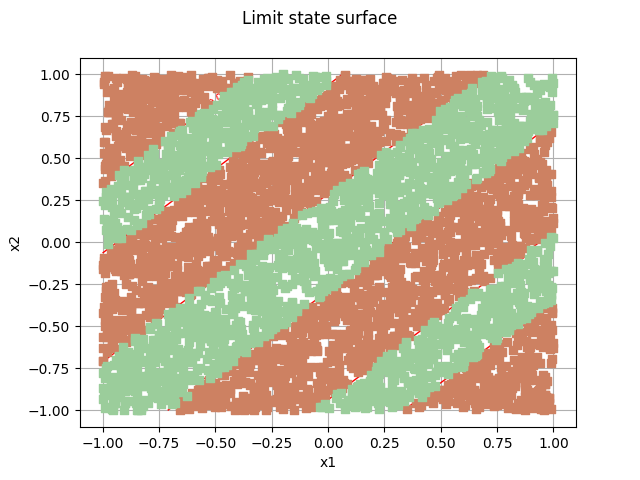
domain = drawEvent.fillEventCrossCut(bounds)
_ = otv.View(domain)
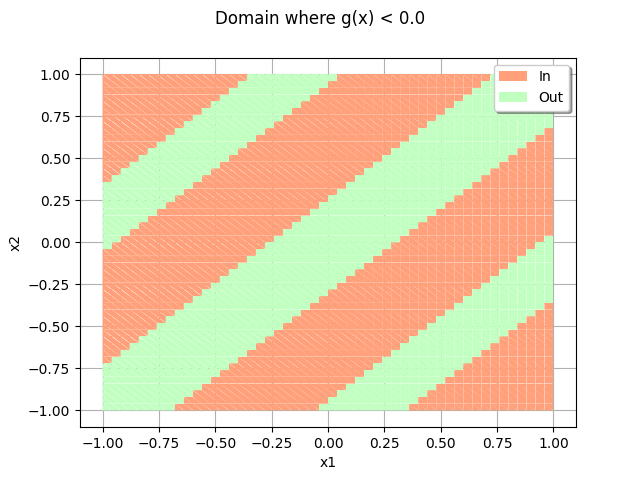
domain.add(cloud)
_ = otv.View(domain)
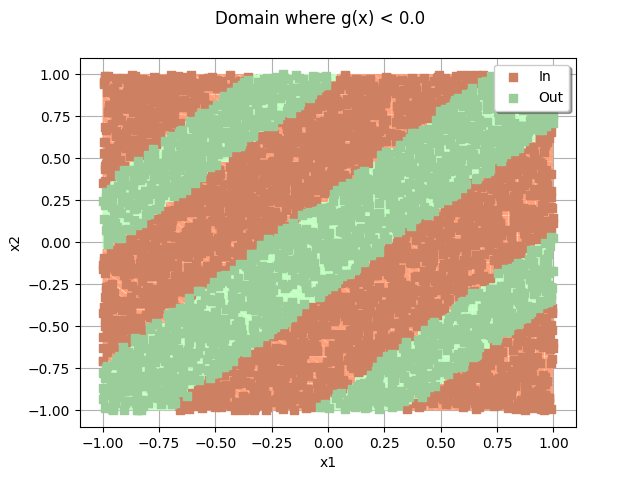
Perform Monte-Carlo simulation¶
algoProb = ot.ProbabilitySimulationAlgorithm(event)
algoProb.setMaximumOuterSampling(1000)
algoProb.setMaximumCoefficientOfVariation(0.01)
algoProb.run()
resultAlgo = algoProb.getResult()
neval = g.getEvaluationCallsNumber()
print("Number of function calls = %d" % (neval))
pf = resultAlgo.getProbabilityEstimate()
print("Failure Probability = %.4f" % (pf))
level = 0.95
c95 = resultAlgo.getConfidenceLength(level)
pmin = pf - 0.5 * c95
pmax = pf + 0.5 * c95
print("%.1f %% confidence interval :[%.4f,%.4f] " % (level * 100, pmin, pmax))
Number of function calls = 43704
Failure Probability = 0.5510
95.0 % confidence interval :[0.5202,0.5818]
With FORM-IS¶
maximumEvaluationNumber = 1000
maximumAbsoluteError = 1.0e-3
maximumRelativeError = 1.0e-3
maximumResidualError = 1.0e-3
maximumConstraintError = 1.0e-3
nearestPointAlgorithm = ot.AbdoRackwitz()
nearestPointAlgorithm.setMaximumCallsNumber(maximumEvaluationNumber)
nearestPointAlgorithm.setMaximumAbsoluteError(maximumAbsoluteError)
nearestPointAlgorithm.setMaximumRelativeError(maximumRelativeError)
nearestPointAlgorithm.setMaximumResidualError(maximumResidualError)
nearestPointAlgorithm.setMaximumConstraintError(maximumConstraintError)
metaAlgorithm = otb.ReliabilityBenchmarkMetaAlgorithm(problem)
benchmarkResult = metaAlgorithm.runFORMImportanceSampling(
nearestPointAlgorithm, maximumOuterSampling=10 ** 5, coefficientOfVariation=0.0
)
print(benchmarkResult.summary())
computedProbability = 0.0
exactProbability = 0.5600144282863704
absoluteError = 0.5600144282863704
numberOfCorrectDigits = 0.0
numberOfFunctionEvaluations = 1006
numberOfDigitsPerEvaluation = 0.0
With Quasi-Monte-Carlo¶
sequence = ot.SobolSequence()
experiment = ot.LowDiscrepancyExperiment(sequence, 1)
experiment.setRandomize(False)
algo = ot.ProbabilitySimulationAlgorithm(event, experiment)
algo.setMaximumOuterSampling(10 ** 3)
algo.setMaximumCoefficientOfVariation(0.0)
algo.setBlockSize(10 ** 3)
algo.run()
result = algo.getResult()
probability = result.getProbabilityEstimate()
print("Pf=", probability)
Pf= 0.5593869999999994
otv.View.ShowAll()
Total running time of the script: (0 minutes 2.461 seconds)
 otbenchmark
otbenchmark